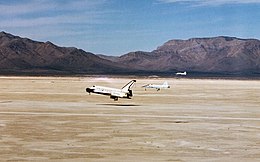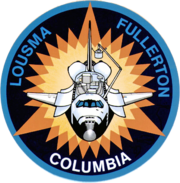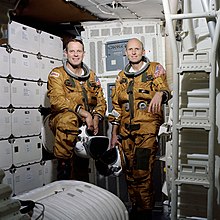 STS-3 landing at Northrop Strip, White Sands, New Mexico, on March 30, 1982, with two T-38 Talon chase planes observing. | |
| Names | Space Transportation System-3 |
|---|---|
| Mission type | Flight test |
| Operator | NASA |
| COSPAR ID | 1982-022A |
| SATCAT no. | 13106 |
| Mission duration | 8 days, 4 minutes, 46 seconds |
| Distance travelled | 5,300,000 km (3,300,000 mi) |
| Orbits completed | 130 |
| Spacecraft properties | |
| Spacecraft | Space Shuttle Columbia |
| Launch mass | 106,782 kg (235,414 lb) |
| Landing mass | 93,924 kg (207,067 lb) |
| Payload mass | 10,301 kg (22,710 lb) |
| Crew | |
| Crew size | 2 |
| Members | |
| Start of mission | |
| Launch date | March 22, 1982, 16:00:00 UTC (11:00 am EST) |
| Launch site | Kennedy, LC-39A |
| Contractor | Rockwell International |
| End of mission | |
| Landing date | March 30, 1982, 16:04:45 UTC (9:04:45 am MST) |
| Landing site | White Sands, Northrop Strip Runway 17 |
| Orbital parameters | |
| Reference system | Geocentric orbit |
| Regime | Low Earth orbit |
| Perigee altitude | 241 km (150 mi) |
| Apogee altitude | 249 km (155 mi) |
| Inclination | 38.00° |
| Period | 89.40 minutes |
| Instruments | |
| |
 STS-3 mission patch  Lousma and Fullerton | |
STS-3 was NASA's third Space Shuttle mission, and was the third mission for the Space Shuttle Columbia. It launched on March 22, 1982, and landed eight days later on March 30, 1982. The mission, crewed by Jack R. Lousma and C. Gordon Fullerton, involved extensive orbital endurance testing of Columbia itself, as well as numerous scientific experiments. STS-3 was the first shuttle launch with an unpainted external tank, and the only mission to land at the White Sands Space Harbor near Alamogordo, New Mexico. The orbiter was forced to land at White Sands due to flooding at its originally planned landing site, Edwards Air Force Base.